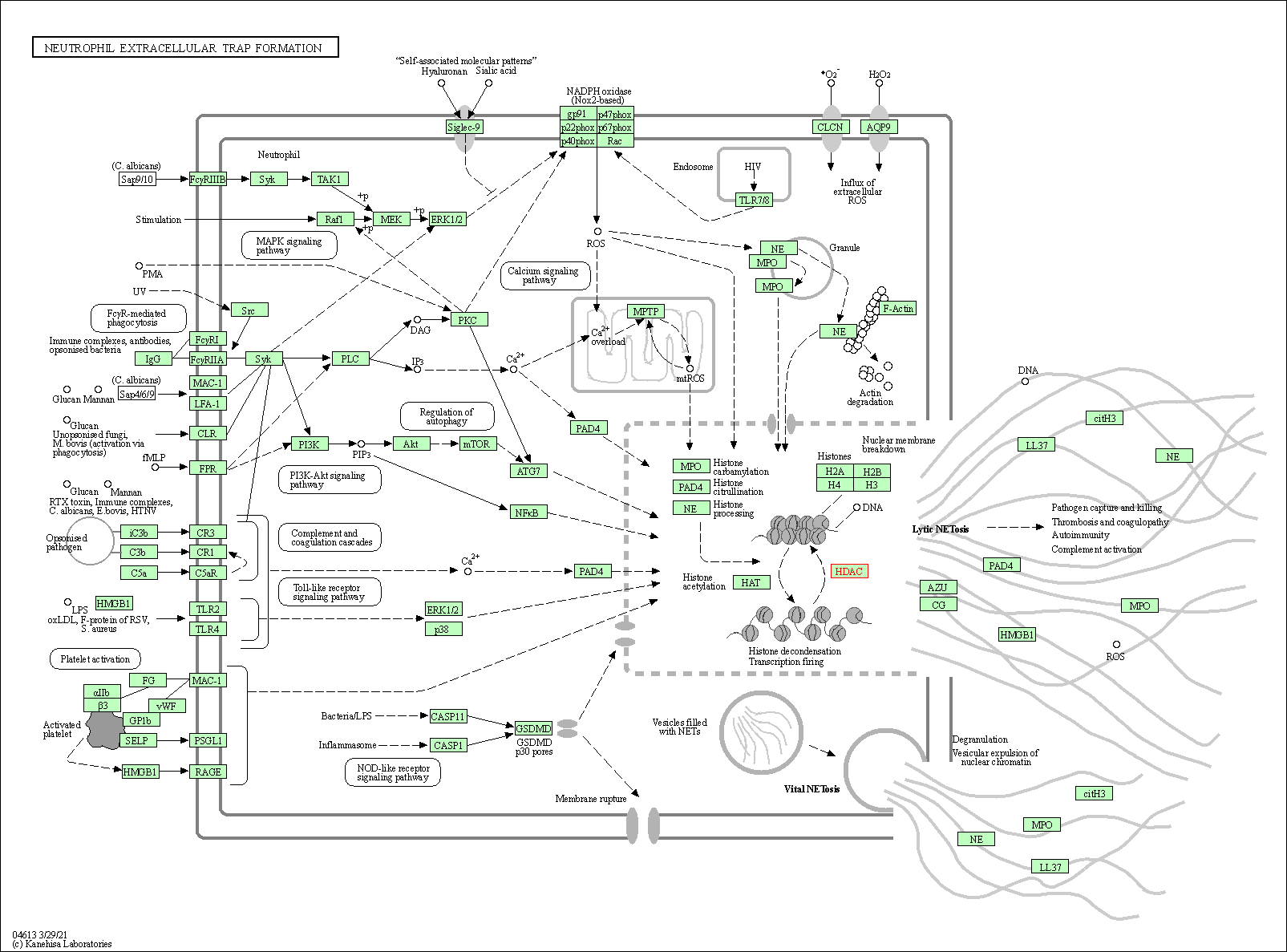Target Information
| Target General Information | Top | |||||
|---|---|---|---|---|---|---|
| Target ID |
T03687
(Former ID: TTDI03262)
|
|||||
| Target Name |
Histone deacetylase 9 (HDAC9)
|
|||||
| Synonyms |
MITR; MEF2-interacting transcription repressor MITR; KIAA0744; Histone deacetylase-related protein; Histone deacetylase 7B; HDRP; HDAC7B; HDAC7; HD9; HD7b
Click to Show/Hide
|
|||||
| Gene Name |
HDAC9
|
|||||
| Target Type |
Patented-recorded target
|
[1] | ||||
| Function |
Gives a tag for epigenetic repression and plays an important role in transcriptional regulation, cell cycle progression and developmental events. Represses MEF2-dependent transcription. Responsible for the deacetylation of lysine residues on the N-terminal part of the core histones (H2A, H2B, H3 and H4).
Click to Show/Hide
|
|||||
| BioChemical Class |
Carbon-nitrogen hydrolase
|
|||||
| UniProt ID | ||||||
| EC Number |
EC 3.5.1.98
|
|||||
| Sequence |
MHSMISSVDVKSEVPVGLEPISPLDLRTDLRMMMPVVDPVVREKQLQQELLLIQQQQQIQ
KQLLIAEFQKQHENLTRQHQAQLQEHIKELLAIKQQQELLEKEQKLEQQRQEQEVERHRR EQQLPPLRGKDRGRERAVASTEVKQKLQEFLLSKSATKDTPTNGKNHSVSRHPKLWYTAA HHTSLDQSSPPLSGTSPSYKYTLPGAQDAKDDFPLRKTASEPNLKVRSRLKQKVAERRSS PLLRRKDGNVVTSFKKRMFEVTESSVSSSSPGSGPSSPNNGPTGSVTENETSVLPPTPHA EQMVSQQRILIHEDSMNLLSLYTSPSLPNITLGLPAVPSQLNASNSLKEKQKCETQTLRQ GVPLPGQYGGSIPASSSHPHVTLEGKPPNSSHQALLQHLLLKEQMRQQKLLVAGGVPLHP QSPLATKERISPGIRGTHKLPRHRPLNRTQSAPLPQSTLAQLVIQQQHQQFLEKQKQYQQ QIHMNKLLSKSIEQLKQPGSHLEEAEEELQGDQAMQEDRAPSSGNSTRSDSSACVDDTLG QVGAVKVKEEPVDSDEDAQIQEMESGEQAAFMQQPFLEPTHTRALSVRQAPLAAVGMDGL EKHRLVSRTHSSPAASVLPHPAMDRPLQPGSATGIAYDPLMLKHQCVCGNSTTHPEHAGR IQSIWSRLQETGLLNKCERIQGRKASLEEIQLVHSEHHSLLYGTNPLDGQKLDPRILLGD DSQKFFSSLPCGGLGVDSDTIWNELHSSGAARMAVGCVIELASKVASGELKNGFAVVRPP GHHAEESTAMGFCFFNSVAITAKYLRDQLNISKILIVDLDVHHGNGTQQAFYADPSILYI SLHRYDEGNFFPGSGAPNEVGTGLGEGYNINIAWTGGLDPPMGDVEYLEAFRTIVKPVAK EFDPDMVLVSAGFDALEGHTPPLGGYKVTAKCFGHLTKQLMTLADGRVVLALEGGHDLTA ICDASEACVNALLGNELEPLAEDILHQSPNMNAVISLQKIIEIQSMSLKFS Click to Show/Hide
|
|||||
| 3D Structure | Click to Show 3D Structure of This Target | AlphaFold | ||||
| HIT2.0 ID | T68DAN | |||||
| Cell-based Target Expression Variations | Top | |||||
|---|---|---|---|---|---|---|
| Cell-based Target Expression Variations | ||||||
| Different Human System Profiles of Target | Top |
|---|---|
|
Human Similarity Proteins
of target is determined by comparing the sequence similarity of all human proteins with the target based on BLAST. The similarity proteins for a target are defined as the proteins with E-value < 0.005 and outside the protein families of the target.
A target that has fewer human similarity proteins outside its family is commonly regarded to possess a greater capacity to avoid undesired interactions and thus increase the possibility of finding successful drugs
(Brief Bioinform, 21: 649-662, 2020).
Human Pathway Affiliation
of target is determined by the life-essential pathways provided on KEGG database. The target-affiliated pathways were defined based on the following two criteria (a) the pathways of the studied target should be life-essential for both healthy individuals and patients, and (b) the studied target should occupy an upstream position in the pathways and therefore had the ability to regulate biological function.
Targets involved in a fewer pathways have greater likelihood to be successfully developed, while those associated with more human pathways increase the chance of undesirable interferences with other human processes
(Pharmacol Rev, 58: 259-279, 2006).
Biological Network Descriptors
of target is determined based on a human protein-protein interactions (PPI) network consisting of 9,309 proteins and 52,713 PPIs, which were with a high confidence score of ≥ 0.95 collected from STRING database.
The network properties of targets based on protein-protein interactions (PPIs) have been widely adopted for the assessment of target’s druggability. Proteins with high node degree tend to have a high impact on network function through multiple interactions, while proteins with high betweenness centrality are regarded to be central for communication in interaction networks and regulate the flow of signaling information
(Front Pharmacol, 9, 1245, 2018;
Curr Opin Struct Biol. 44:134-142, 2017).
Human Similarity Proteins
Human Pathway Affiliation
Biological Network Descriptors
|
|
|
There is no similarity protein (E value < 0.005) for this target
|

| KEGG Pathway | Pathway ID | Affiliated Target | Pathway Map |
|---|---|---|---|
| Neutrophil extracellular trap formation | hsa04613 | Affiliated Target |

|
| Class: Organismal Systems => Immune system | Pathway Hierarchy | ||
| Degree | 6 | Degree centrality | 6.45E-04 | Betweenness centrality | 1.40E-05 |
|---|---|---|---|---|---|
| Closeness centrality | 2.12E-01 | Radiality | 1.37E+01 | Clustering coefficient | 6.67E-02 |
| Neighborhood connectivity | 2.50E+01 | Topological coefficient | 2.17E-01 | Eccentricity | 11 |
| Download | Click to Download the Full PPI Network of This Target | ||||
| Chemical Structure based Activity Landscape of Target | Top |
|---|---|
| Drug Property Profile of Target | Top | |
|---|---|---|
| (1) Molecular Weight (mw) based Drug Clustering | (2) Octanol/Water Partition Coefficient (xlogp) based Drug Clustering | |
|
|
||
| (3) Hydrogen Bond Donor Count (hbonddonor) based Drug Clustering | (4) Hydrogen Bond Acceptor Count (hbondacc) based Drug Clustering | |
|
|
||
| (5) Rotatable Bond Count (rotbonds) based Drug Clustering | (6) Topological Polar Surface Area (polararea) based Drug Clustering | |
|
|
||
| "RO5" indicates the cutoff set by lipinski's rule of five; "D123AB" colored in GREEN denotes the no violation of any cutoff in lipinski's rule of five; "D123AB" colored in PURPLE refers to the violation of only one cutoff in lipinski's rule of five; "D123AB" colored in BLACK represents the violation of more than one cutoffs in lipinski's rule of five | ||
| Target Poor or Non Binders | Top | |||||
|---|---|---|---|---|---|---|
| Target Poor or Non Binders | ||||||
| Target Regulators | Top | |||||
|---|---|---|---|---|---|---|
| Target-regulating microRNAs | ||||||
| Target-interacting Proteins | ||||||
| References | Top | |||||
|---|---|---|---|---|---|---|
| REF 1 | HDAC inhibitors: a 2013-2017 patent survey.Expert Opin Ther Pat. 2018 Apr 19:1-17. | |||||
| REF 2 | Selective class IIa histone deacetylase inhibition via a nonchelating zinc-binding group. Nat Chem Biol. 2013 May;9(5):319-25. | |||||
If You Find Any Error in Data or Bug in Web Service, Please Kindly Report It to Dr. Zhou and Dr. Zhang.

